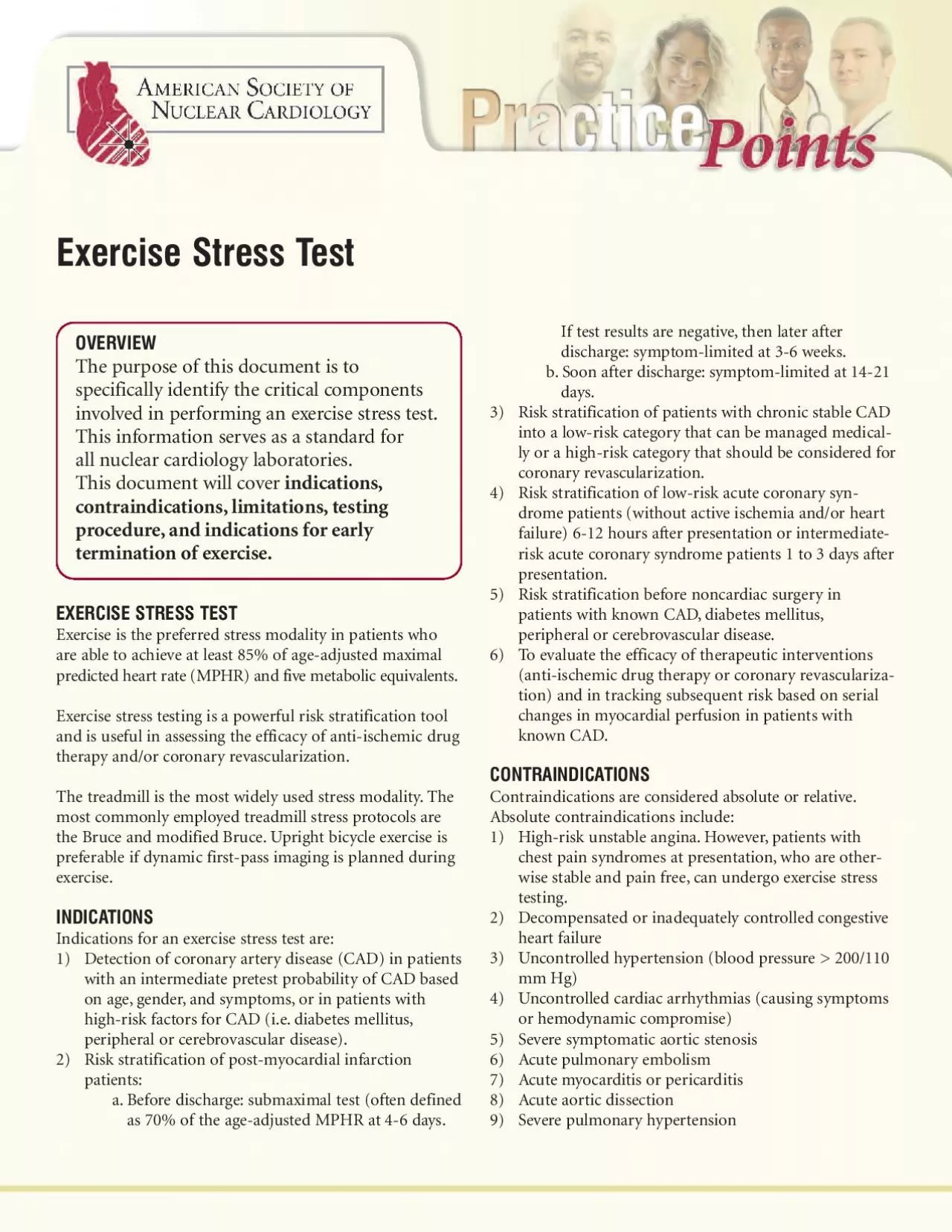

CONTRAINDICATIONS Contraindications are considered absolute or relativeAbsolute contraindications include1 Highrisk unstable anginaHoweverpatients withchest pain syndromes at presentationwho ar ID: 953796
Download Pdf The PPT/PDF document "Iftest results are negativethen later af..." is the property of its rightful owner. Permission is granted to download and print the materials on this web site for personal, non-commercial use only, and to display it on your personal computer provided you do not modify the materials and that you retain all copyright notices contained in the materials. By downloading content from our website, you accept the terms of this agreement.
Iftest results are negative,then later after discharge:symptom-limited at 3-6 weeks.b.Soon after discharge:symptom-limited at 14-21 days.3) Risk stratification ofpatients with chronic stable CADinto a low-risk category that can be managed medical-or a high-risk category that should be considered foronary revascularization.ification oflow-risk acute coronary syn-drome patients (without active ischemia and/or heartfailure) 6-12 hours after presentation or intermediate-isk acute coronary syndrome patients 1 to 3 days afterpresentation.5) Risk stratification before noncardiac surgery inetes mellitus,peripheral or cerebrovascular disease.To evaluate the efficacy oftherapeutic interventionsmic drug therapy or coronary revasculariza-tion) and in tracking subsequent risk based on serialchanges in myocardial perfusion in patients withknown CAD. CONTRAINDICATIONS Contraindications are considered absolute or relative.Absolute contraindications include:1) High-risk unstable angina.However,patients withchest pain syndromes at presentation,who are other-wise stable and pain free,can undergo exercise stresstesting.2) Decompensated or inadequately controlled congestiveure3) Uncontrolled hypertension (blood pressur�e 200/110rolled cardiac arrhythmias (causing symptomsor hemodynamic compromise)mptomatic aortic stenosis6) Acute pulmonary embolism7) Acute myocarditis or pericarditis8) Acute aortic dissection9) Severe pulmonary hypertension Exercise Stress Test The purpose ofthis document is to specifically identify the critical componentsinvolved in performing an exercise stress test.This information serves as a standard for all nuclear cardiology laboratories.This document will cover indications,ontraindications,limitations,testing procedure,and indications for early termination ofexercise. EXERCISE STRESS TEST eferred stress modality in patients whofage-adjusted maximalpredicted heart rate (MPHR) and five metabolic equivalents.cise stress testing is a powerful
risk stratification tooland is useful in assessing the efficacy ofanti-ischemic drugtherapy and/or coronary revascularization.dmill is the most widely used stress modality.Themost commonly employed treadmill stress protocols arethe Bruce and modified Bruce.Upright bicycle exercise isdynamic first-pass imaging is planned duringexercise. INDICATIONS ndications for an exercise stress test are:1) Detection ofcoronary arterCADCADientsrmediate pretest probability ofCAD basedon age,gender,and symptoms,or in patients withhigh-risk factors for CAD (i.e.diabetes mellitus,al or cerebrovascular disease).2) Risk stratification ofpost-myocardial infarctionpatients:a.Before discharge:submaximal test (often definedas 70% ofthe age-adjusted MPHR at 4-6 days. 10) Acute myocardial infarction (less than 4 days)11) Acutely ill for any reasonRelative contraindications for exercise stress testinginclude:1) Known left main coronary artery stenosis2) Moderate aortic stenosisHypertrophic obstructive cardiomyopathy or otherforms ofoutflow tract obstruction4) Significant tachyarrhythmias or bradyarrhythmias5) High-degree atrioventricular block6) Electrolyte abnormalitiesental or physical impairment leading to inability tocise adequately LIMITATIONS Exercise stress testing has a lower diagnostic value innts who cannot achieve an adequate heart rate andblood pressure response. Note: Ifcombined with imaging,patients with complete leftrmanent pacemakers,and ventricular pre-excitation (Wolff-Parkinson-Whitesyndrome) should preferentially undergo a pharmacolog-ic vasodilator stress (not a dobutamine stress test). TESTING PROCEDURE nts may not eat 2 hours before the test.Patientsscheduled for later in the morning may have a lightExercise stress tests require:1) Properly trained nurses,nurse practitioners,physicianassistants,and medical technicians to administer testsand an appropriately trained supervising physiciandiately availableecords ofthe heart rate,a 12-lead ECG,and bloodpressure
at each stage ofexercise.Records should alsopearance ofany clinical symp-toms.All measurements are repeated during recovery,typically every 3 minutes for at least 5 minutes afterrcise.3) Continuous electrocardiographic monitoring duringthe test and in the recovery period.Monitoring is con-tinued for at least 5 minutes into the recovery periodor until the resting heart rate is less than 100 beats perminute or dynamic ST segment changes have resolved.4) A large bore (18 to 20 gauge) intravenous cannula forradiopharmaceutical injection5) Radiopharmaceutical injection as close to peak exercise as possibleExercise for at least 1 minute after radiopharmaceuti-cal injection TERMINATION OF EXERCISE All exercise tests should be symptom-limited.Achieve-ment of85% ofage-adjusted MPHR is not an indicationfor termination ofthe test. ients who cannot exercise adequately (eg.,achievedjusted MPHR prior to radiopharmaceuticalor at least 1 minute following radio-tracer administration;achieve 5 METS or 5 minutes totalexercise time on a Bruce protocol),the radiotracer shouldcted at peak exercise and a pharmacologic stressest should be considered.Blood pressure medicationsith antianginal properties will lower the diagnostic accu-racy ofa stress test.However,testing patients with CAD onhemic regimens may be useful in monitoringtheir response to therapy.Indications for early termina-tion ofexercise include:ate to severe angina pectoris2) Marked dyspnea or fatigue3) Ataxia,dizziness,or near-syncope4) Signs ofpoor perfusion (cyanosis and pallor)5) Patient픀s request to terminate the test6) Excessive ST-segment depressio픀 2mm 2mmST elevatio픀 1mm 1mmds without diagnostic Qxcept for leads V 8) Sustained supraventricular or ventricular tachycardialopment ofLBBB or intraventricular conductiondelay that cannot be distinguished from ventriculartachycardia10) Drop in systolic blood pressure ofgreater than 10mmHg from baseline,despite an increase in workload, Exercise Stress Test